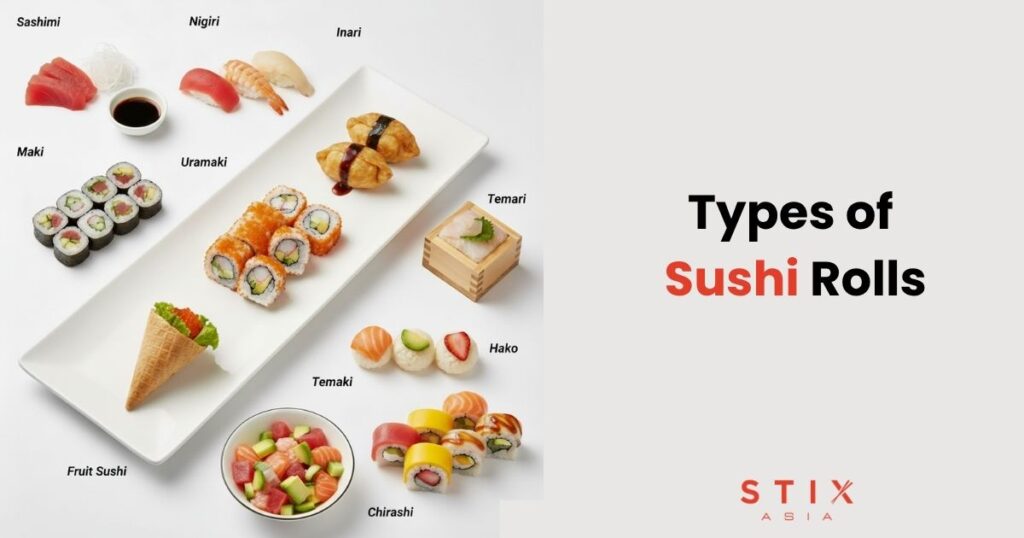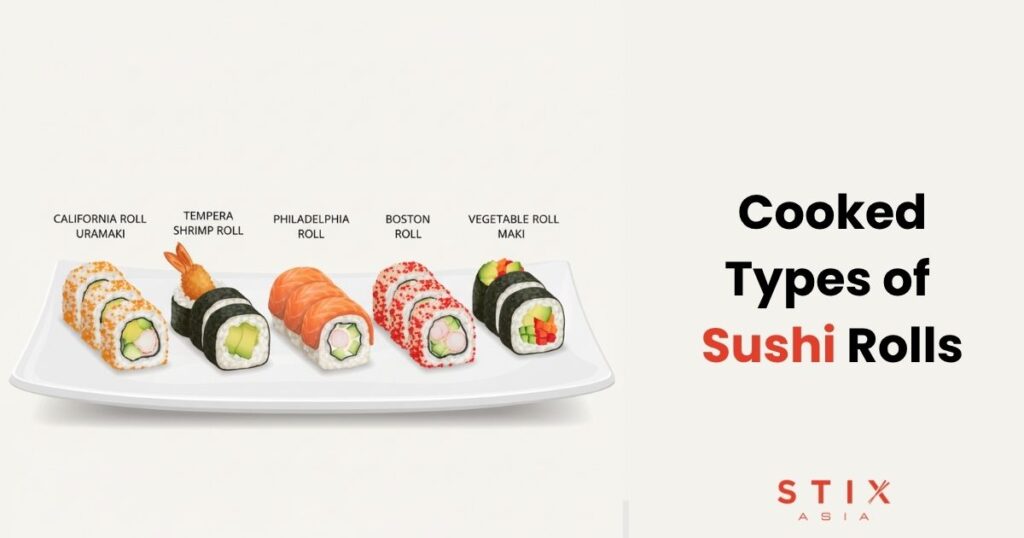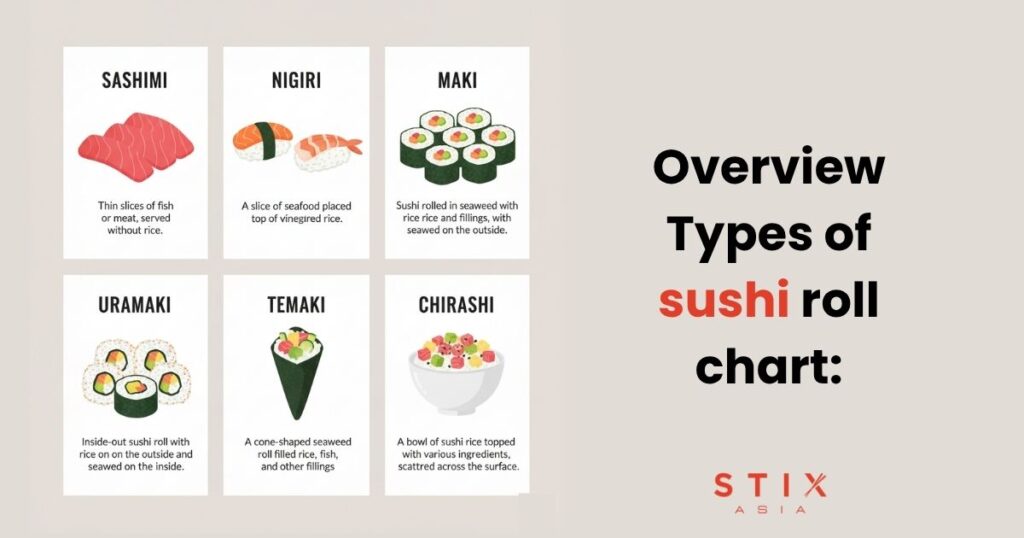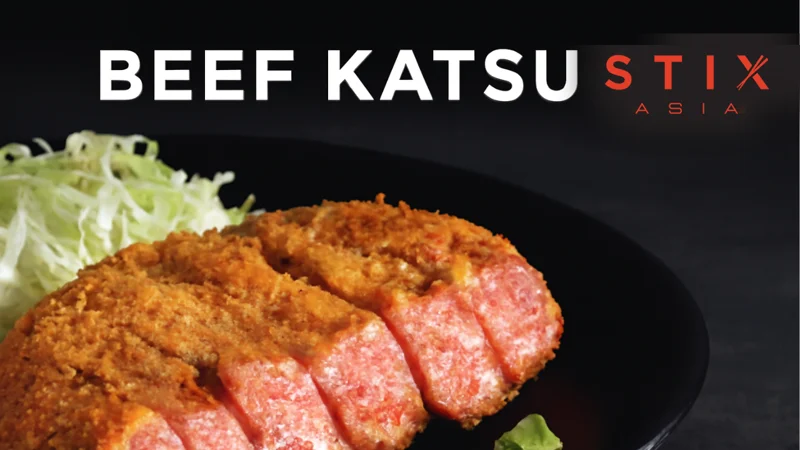Sushi rolls come in various types, each offering unique flavors and ingredients. Popular types include Nigiri, Maki, Uramaki, and Temaki, with both raw and cooked options available. Each roll has its own distinctive preparation style, such as rice on the outside or inside-out rolls.
If you’re a sushi lover or just starting to explore the world of sushi, knowing the different types of rolls is key to enhancing your experience. From the traditional simplicity of Nigiri to the creative flair of Uramaki rolls, this guide will help you understand what makes each type special and why you should give them a try!
Whether you’re looking for raw seafood, crunchy tempura, or fresh vegetable options, there’s a sushi roll for everyone. Keep reading to discover which type might be your next favorite!
What is Sushi?
Sushi is a Japanese dish made with medium-grain vinegar rice, served with raw or cooked seafood and various fillings or toppings. Sushi rice is the main component of sushi, not the raw fish.
For sushi, there is one necessary condition that there must be rice, and the rice must be prepared with a special type of vinegar known as sushi vinegar, made up of rice vinegar, salt, and sugar. This gives the rice its premium taste and a sticky texture.
Sushi vs. Zushi: Understanding the Key Differences
Some sushi menus represent an alternative spelling starting with “z,” confusing many people. But the fact is, in Japanese, sushi becomes zushi when indicating specific types of sushi. For example, maki sushi becomes maki zushi. The only difference between sushi and zushi is pronunciation, and sushi means sushi generally, but zushi means a special type of sushi.
Different Types of Sushi Rolls You Should Try

One of the best things about sushi is, it offers something for everyone. From raw seafood to cooked meat to veggies, it covers all sushi enthusiasts!
Here is a brief explanation of 10 popular sushi roll types:
Sashimi:
Let it be very loud and clear that Sashimi isn’t a type of sushi, because we just established the fact that for anything to be sushi, sushi rice is a must, and sashimi has no rice. Now you might wonder if it’s not sushi, why we’re starting the last from it, because it’s very famous and one of the most important Japanese cuisines. Many first-time sushi eaters confuse sashimi with sushi, and that’s why we thought to clear this up before.
Sashimi is thinly sliced fish or meat, usually raw. You can choose any type of meat, but seafood and fish are the most common types. Though originally it’s served raw, today cooked sashimi is also a popular option, especially in the case of unagi (grilled eel).
Sashimi is served with daikon radish and Asian sauces, and generally, there are no toppings because the real essence of sashimi is to enjoy the fresh flavor of the fish.
Nigiri:
Nigiri is a type of sushi made from vinegared rice with a topping of raw or cooked seafood. And these two ingredients are all that make up nigiri. The seasoning and the sauces are additional; you can use them for your taste, but in Japan, nigiri is considered a simple delicacy.
Maki:
It’s made by a seaweed sheet containing vinegared rice and fillings. It’s rolled into tubes and sliced into bite-sized pieces. The thin seaweed paper is known as Nori. If you look at a slice of Maki sushi, you’ll see fillings and a coating of rice.
Uramaki:
Uramaki is completely opposite to Maki. In this sushi, the rice is on the outside and the nori is on the inside. The inside-out Uramaki roll doesn’t originate from Japan. In fact, these rolls were created by a Los Angeles sushi chef, Machito Ichiro, who wanted to appeal to American sushi customers. He noticed that American customers don’t like seaweed wrapping as in traditional maki sushi, so he did the opposite and won the hearts!
This is the reason Uramaki is the most popular type of sushi roll in the US.
Inari:
Inari is a unique spin on traditional sushi. It’s made by placing ingredients into a fried tofu pouch marinated in a sweet sauce. Best for sushi lovers who enjoy sweet and sour combinations.
Temaki
This sushi is unique from the rest of the sushi roll types in our list. It consists of a large seaweed cone filled with rice, fish, and other fillings. It’s different from maki rolls; it’s a little more deconstructed and is generally eaten by hand as a single serving.
Chirashi
It’s a less common type of sushi, in which a bowl of sushi rice is covered with different toppings. And its literal meaning represents its presentation beautifully. Chirashi literally means” scattered,” and so does the topping on sushi rice. But the twist is, besides being scattered, you’ll probably love chirashi because of its neatness and precision.
Hako:
Hako is a hand-pressed type of sushi, made by putting rice and sushi constituents in a small square wooden box known as Oshibako. Then it’s pressed down to create uniform sushi.
Temari:
Temaki are hand-pressed types of sushi, also known as hand balls. It’s a unique type of sushi usually eaten by hand. These are made by pressing vinegared rice into small palm-sized rounds and seasoning with raw seafood or veggies.
Fruit Sushi
It’s a type of sushi in which fruits such as mangoes, strawberries, and kiwis are used as toppings for Nigiri and Maki. The acidity of the vinegared rice and the sweetness of the fruit make a balanced taste.
5 Cooked Types of Sushi Rolls:

California Roll:
Until now, California rolls are the best types of sushi rolls in the US. It’s a type of Uramaki roll ( the one Los Angeles chef made for Americans) made from crab, avocados, and cucumber wrapped in a nori wrap and rice. It’s usually garnished with tobiko, massage, or sesame seeds.
Tempura Shrimp Roll
It can be prepared both as a Maki or Uramaki roll. As the name indicates, its main ingredient is fried shrimp, giving it a crunchy texture. Cucumbers and avocados are used for fillings.
Philadelphia Rolls:
It’s also a type of Uramaki rolls, made up of raw or smoked salmon, cheese cream and cucumber, and nori. The cheesy cream and the smoky salmon create a delicious taste.
Boston Roll
Boston rolls are made from shrimp, avocado, and cucumber. It’s also a type of uramaki roll. Boston roll has a signature red or orange color because of tobiko or masago toppings.
Vegetable Roll
Best for people trying sushi for the first time. It can be made as a maki or uramaki roll. It consists of a variety of vegetables such as cucumbers, carrots, avocados, and red peppers, and carrots.
Read here: How to eat sushi like a pro?
What’s the Best Sushi Roll?
This is something very subjective. For die-hard sushi lovers, Nigiri might be the best. For mild taste, maki roll wins, and for most Americans, uramaki roll, such as California rolls, spicy tuna roll, or dragon roll, are usually the best, because they satisfy their palate.
Try the Best Sushi Roll
Craving sushi? Come to Stix Asia for the freshest rolls in Waikiki and Las Vegas. Explore Authentic sushi in honolulu and taste the difference!
Quick Overview of types of sushi roll chart:

FAQs:
Difference Between Nigiri and Maki?
The difference is simple. The rice in nigiri is pressed into one bite-sized mound. On the other hand, maki sushi is rolled into a tube and sliced into rolls. Also, Nigiri contains just one piece of fish, and maki rolls contain fillings on the inside.
Is Sushi good for health?
Yes! Generally, sushi is good for health. It’s made from rice, fish, or meat, and all three basic components are a good source of protein.
Difference Between Sashimi and Sushi?
Sushi always contains rice, raw or cooked meat, and toppings, whereas sashimi is just a slice of meat or fish, and originally raw. You can say, sashimi is “no-rice sushi”.




